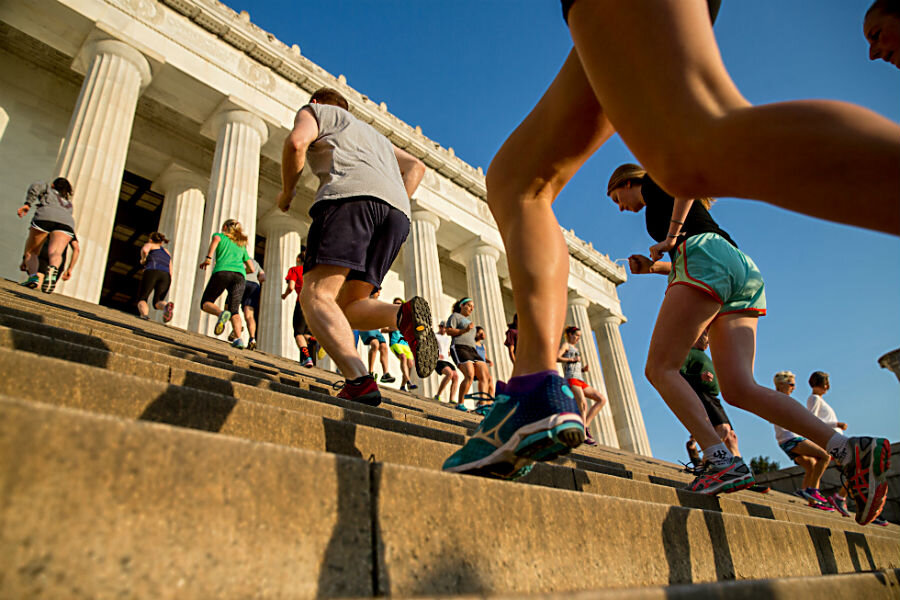Why workout clubs gather at national landmarks
When college rowing buddies Bojan Mandaric and Brogan Graham vowed to stay in shape post-graduation, they didn't want to shovel out hundreds to join a gym or even drop $20 for a yoga class. So they returned to one of their most grueling college workouts: the stairs at Harvard Stadium.
Five years later, there are nearly 800 others running those steps with them at 6:30 a.m. every Wednesday. Their routine, known as the November Project, now has thousands of participants and free workout clubs in 20 cities, capitalizing on what's become a popular fitness trend, with other groups and individuals also gathering in iconic spots to get their sweat on.
Sites include national monuments, historic landmarks and other public spaces around the country, ranging from the Lincoln Memorial in Washington, D.C., to the Hollywood Bowl in Los Angeles, to New York City's Gracie Mansion, the historic home where the mayor lives.
The mountains of stairs and wide stone platforms at these sites are ideal for box jumps, step routines and tricep dips. Often the workouts must be held at dawn before the tourist crowds arrive with selfie sticks. But the scenic views these landmarks offer cannot be rivaled by looking out the window of a non-descript gym.
"It creates a sentimental way to connect with your city," said Mandaric. "There's a romantic component to it, you're working out, endorphins are flowing, you're meeting cool new people."
In Pennsylvania, the hot spot is the Philadelphia Museum of Art's front steps — best known for the famous scene from the movie "Rocky" where Sylvester Stallone's character culminates his morning jog and jumps triumphantly. CoreFitness' Lauren Krinis' 6 a.m. class draws about 45 people.
"It really is fun to watch people who think, 'I could never run up and down the stairs,' who then go run it four or five times and do a full boot camp class or yoga session. It's probably one of the most motivating places you can work out," Krinis said.
Some parks have imposed restrictions on fitness groups, requiring classes to be free or banning classes above a certain size. National Park Service officials say parks can play an important role in contributing to a healthy America and encourage their use for exercise, but many memorials and monuments have areas where jogging and group workouts are not allowed, in order to "maintain a reflective and contemplative atmosphere."
Still, the National Mall, home to the Lincoln Memorial, hosts International Yoga Day and the Marine Corps Marathon, and November Project groups work out at the Lincoln Memorial steps early Wednesday mornings.
At the iconic Red Rocks Amphitheatre in Denver, Joe Hendricks' free workout on Saturday mornings had been drawing a few hundred people. But two years ago, he said, the city ordered groups with more than 20 people to limit sessions to Sunday only.
Now, roughly 200 join him for a Sunday workout that includes everything from backward crawls up the bleachers to "piggy back" exercises where you carry your partner. Hendricks, 53, leads the workouts alongside several other fitness groups and soloists at the sandstone monoliths where the Great Plains meet the Rocky Mountains.
"It's a workout mecca really for Denver. It's just so energizing to have so many people around you and real motivating. People are high-fiving each other. Most people there are working out much harder than they would on their own," he said.
Kim Wagler leads free boot camp classes and a walking club at the McKinley Presidential Library & Museum in Canton, Ohio, which has 108 steps. "A lot of people are terrified to join a gym because they're afraid of feeling uncomfortable and that's a nice place where there's a wide variety of people there," Wagler said. "You're not just going to show up and everyone is super fit and super lean."
But some visitors have complained about runners and walkers at the monument. "We do not want the grounds to be an outdoor gym. It is disrespectful to the president," McKinley site director Joyce Yut said in an email.
On a recent Wednesday at the Lincoln Memorial in Washington, one of the nation's most popular tourist destinations, 39-year-old Mary Kusler was pushing her way through a vicious circuit of 17 times up the steps.
"It reminds you of the beauty of D.C., of the calmness before the craziness of the everyday life here in D.C.," said Kusler, who's been working out at the memorial for two years. "The people are what you come back for. The stairs and the getting fit in the process is an added bonus."
It's a sentiment that is echoed by other workout groups. Hendricks met his wife of five years at his Red Rocks boot camp.
"It's become almost like a social group," he said. "This summer alone there are nine weddings happening of people that have met at my group."
___
Associated Press writer Jessica Gresko contributed to this report from Washington.






